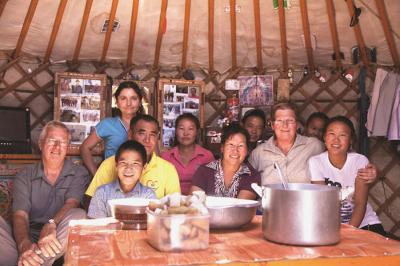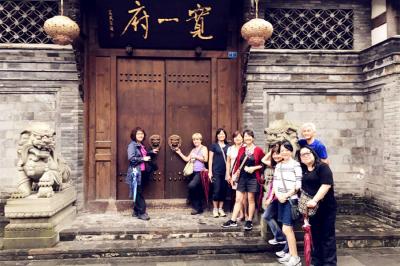China Silk Road Train Tour from Beijing
Overview

Follow in the ancient merchant travelers’ footsteps to explore the great Silk Road – yet you got an easier and better way – exploring this ancient trading route by bullet train. The 20 days Silk Road tour starts from Beijing with the Great Wall visit, then come to Xian, or previously named Chang’an, the initial starting point of the Silk Road. Head west, getting to Gansu province to explore desert, Buddhist grottoes & shrines, Zhangye Danxia Landform, ancient military fortress… Travel further along the Silk Road to Xinjiang, to discover the ancient kingdom ruins, heaven-like lakes, Islamic mosques & tombs, and more!
The tour itinerary is separated into two parts. You can finish it in Dunhuang, or continue the entire China Silk Road journey including Xinjiang.
Duration: 20 days & 19 nights
Destinations: Beijing - Xian - Lanzhou - Zhangye - Jiayuguan - Dunhuang - Turpan - Kashgar - Urumqi
Travel Style: Private tour
Customize Your Tour:
☑ Travel Dates ☑ Your Interests ☑ Your Travel Style
Itinerary Expand All
Despite its rapid modern progress, Beijing is old and traditional. To discover the traces of powerful dynasties of Beijing, you must visit Forbidden City, which is located in the heart of the city, right next to Tiananmen Square and many historical sites. You guide will lead you to have an in-depth visit of Forbidden City, the imperial palace for 24 kings. Delve into China’s history, culture, architecture and art. In the afternoon, explore Beijing’s real cultural root – the hutong, on the vintage pedicab, going back to the 19th to 20th-century. Imagine the legendary stories happening in these alleyways and courtyards. The local Beijingers still live a traditional life here.
Meal: B, L

Morning time is the best time to visit Temple of Heaven, even though you may expect more tourists. This ancient sacred site is still perfectly preserved and considered a masterpiece of traditional Chinese architecture. It used to serve as the site for the kings to connect with the gods in heaven; but now, it become a popular park for the locals to do morning exercise and practice Tai Chi. This afternoon, go explore Mutianyu Great Wall, absolutely, the most important sight to visit in Beijing, and even China. Learn from your expert guide why and how it was constructed. View the world from the mountaintop Great Wall. The cable car can be included to save energy.
Meal: B, L

Another world heritage in Beijing, Summer Palace is one of the best traditional Chinese gardens, featuring royal dignity. It was perfectly designed based on natural mountains and rivers. Walk around this Qing Dynasty palace to find pavilions, pagodas, corridors, towers, temples, bridges… Catch your high speed train to Xian (about 4-5 hrs), one of the four ancient capitals in the world, and the starting point of Silk Road. Xian reached its heyday during Han and Tang Dynasty. Thanks to the Silk Road at that time, people from all over the world could follow the trend and fashion of Xian.
Meal: B, L
Dating to more than 2200 years ago, Xian was the capital during Qin Dynasty. Emperor Qinshihuang united China with ultimate power, wisdom and weapon. After he died, Terracotta Army, made up of thousands of life-sized warriors and horses, became his burial objects. You’ll meet with this great army and learn about the legend. Drive back to downtown Xian, visiting the Great Mosque of Xian, blending Chinese and Islamic architectural style. You may have a comparison between this one and those mosque in Gansu & Xinjiang. End of the day with a stroll along the Muslim Quarter, witnessing local life and with chance to taste hundreds of street foods.
Meal: B, L

The ancient city wall of Xian witnessed both the city’s and the Silk Road’s glory past. The wall is 12 meters high, 12 -- 14 meters wide at the top and 15 -- 18 meters wide at the bottom. The outline is a closed rectangle with a circumference of 13.74 kilometers. Then visit Big Wild Goose Pagoda – the most famous pagoda on the Silk Road - inside Da Ci’en Temple. It still keeps the Buddhist relics and classics brought by Master Xuanzang after he traveled through the Silk Road from ancient India. Learn more history and witness more cultural treasures at Shaanxi History Museum, before heading for Lanzhou by speed train (about 3hrs).
Meal: B, L
Drive about 5 hours from Lanzhou to Xiahe County inhabited mainly by Tibetans, enjoying the wild West China scenery. Visit Binglingsi Temple Caves en route. The cave grottoes were initially dug on the cliff in the 3rd-century during China’s West Jin Dynasty. Bingling in Tibetan means thousand-Buddha. There are still 183 grottoes, along with 694 stone statues, 82 clay statues and 900-sq-m murals. Stay overnight at Xiahe.
Meal: B, L

Wake up in this small peaceful town. Drive for 0.5km to visit Labrang Monastery. It is one of the six monasteries of the gelug sect of Tibetan Buddhism. There are more than 90 temple halls, including six colleges, 16 Buddhist shrines, living Buddha palace, monks’ dormitory, preaching altar, dharma court, sutra printing house, Buddhist pagoda, etc. Here you can also know about Buddhist medicine. Drive back to Lanzhou.
Meal: B, L
Leave Lanzhou and continue your train journey along Silk Road, getting to Zhangye (about 4hrs). head for the dreamlike Danxia Landform Geological Park, known as the “Rainbow Mountain in China” and one of the most beautiful places on Earth. Take in the breathtaking view of the colored landscape. Watch the sun sets down the mountain if weather permits.
Meal: B, L

After breakfast, visit Dafo Temple (Giant Buddha Temple), built in 1098, during the West Xia Kingdom Period. It is home to the largest indoor reclining Buddha in China, as long as 34.5m. Then head for Jiayuguan by bullet train (about 1.5hrs). After arrival, visit Jiayuguan fortress - the west end of the Great Wall built in Ming Dynasty. This magnificent, well-preserved ancient military fort is famed as "The First and Greatest Pass under the Heaven".
Meal: B, L
Move to Dunhuang by bullet train. As you travel further along the Silk Road, you see more of the wilderness and historical ruins. Upon arrival, transfer to visit Yumen Pass (Jade Pass). It was so named because jade was imported to China through this pass after being transported via the Silk Road. Then have a look of the Ruined Great Wall of Han Dynasty.
Meal: B, L
This morning, pay a visit to Mogao Grottoes, one of the four greatest grottoes in China and a world cultural heritage site. With more than seven hundred grottoes and 45,000-sq-m murals and over two thousand Buddha sculptures, Mogao Grottoes is also the greatest Buddhist art shrine in the world. Desert is a must-see sight during your Silk Road trip. Visit Singing Sand Mountains and Crescent Moon Lake to see the oasis in desert.
You can finish your Silk Road tour in Dunhuang or continue it, driving to Liuyuan Railway Station (2.5hrs) to board your bullet train to Turpan (3h15min).
Meal: B, L

Admire Karez Irrigation System, a unique irrigation system in China’s desert region created by ancient Uygur people. It has been regarded as one of the three great engineering projects of ancient China (the other two are the Great Wall and Beijing-Hangzhou Grand Canal). There are over 1100 Karez irrigation systems in Turpan. Then visit Jiaohe Ruins – world’s largest, oldest and best-preserved city made of earthen buildings. Emin Minaret is the next spot, an existing largest minaret in Xinjiang with a circular shape, It is 44 meters high with a diameter of 10 meters. The huge structure was built of grey bricks and earth in 15 different decorative patterns such as waves, flowers or rhombuses. At last, go to the Desert Botanical Garden and gain the knowledge of desert plants.
Meal: B, L

In the morning pass by the Flaming Mountain, a legendary mountain in the Chinese literature classic of “Journey to the West”. Visit the Ruins of Gaochang, once a prosperous city on the Silk Road and the center of Turpan between 1st-century BC and 14th-century AD. You can still find many scared religious sites, ruins of palaces, and Buddhist murals and Buddha statues. Then visit The Bezeklik caves for more Buddhist grottoes art and Astana Ancient Tombs (3rd - 8th Century).
Meal: B, L
Drive for three hours from Turpan to Urumqi. Visit Xinjiang Provincial Museum, one of the best places to learn history of Xinjinag and the Silk Road. There are numerous cultural relics and classics, including silk handicraft and the Chinese mummy. Later have fun at Erdaoqiao Grand Bazaar. The bazaars were critical to the trading between the East and West on the Silk Road. Here you can witness local people’s life, see all kinds of snack foods and articles of daily use are for sale, and hear different sounds around you – made by donkey, human and vehicle.
Meal: B, L

Enjoy a full day tour to the Heavenly Lake, which is at an elevation of 2000 meters. The beautiful lake is flanked by rugged pines and cypresses, with melted clear waters reflecting the surrounding of snow capped highest peak-Bogda (5445 m). Enjoy boating in the lake. Thereafter, transfer to the airport and fly to Kashgar.
Meal: B, L
Kashgar’s morning is very busy and lively, especially on Sunday. Join the local Uyghur people to wander around at the Sunday market of Kashgar, the largest outdoor market in the Mid-Asia to taste local breakfast, and experience the unique exotic atmosphere! Afternoon visit the Mausoleum of Abakh Khoja of original Islamic style, Etgar Mosque and the old town of the city for more historical traces and long-gone life.
Meal: B, L
Drive along Karakurum Highway, taking in wild natural landscape and getting to Karakul Lake (around 180km). At the food of snow-capped Muztagh Ata – known as the father of iceberg, Karakul Lake looks so peaceful, mysterious and enticing. Besides the lake is the vast grassland where the sheep and cattle are grazing. Guess that a beautiful image has come to your mind. On the way back, visit the Muhammed Kashgari’s Tomb Complex.
Meal: B, L

Today, you will visit Xinjiang and even China’s biggest mosque - Id Kah Mosque, initially built in 1442. It is the centre of the Moslem activities, with thousands of Muslims getting here every day. Then visit the Abakh Khoja Tomb which is served as the family tomb of Abakh Khoja, the powerful ruler of Kashgar in the 17th century who was revered as a prophet and second only to Mohammed. Later, go to the local Kindergarten to get close to children there and know things about their life.
Meal: B, L




